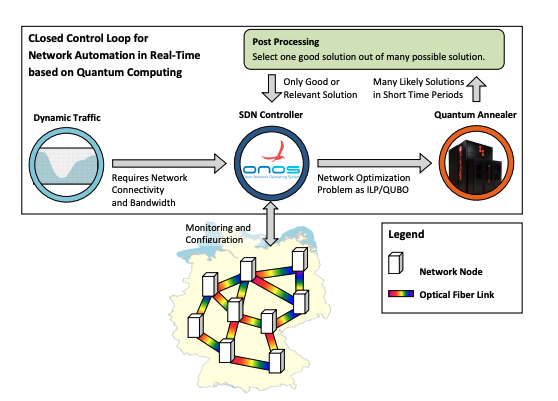The article explores a centralized network control algorithm that can be executed on existing quantum computers. The algorithm, based on quantum annealing, optimizes traffic engineering in wide-area networks, particularly during traffic fluctuations or spontaneous bursts. It also introduces a discrete-time flow simulator to study the algorithm’s performance. The article suggests that quantum computing can significantly reduce traffic losses and overprovisioning of networks, leading to a zero-margin network operation. This new form of network operation could be the future of network automation.
What is the Quantum Computing Readiness of Queue aware Network Control Algorithm?
The article discusses a centralized network control algorithm that can be executed on existing quantum computers. The algorithm, based on the principle of quantum annealing, is a resource reoccupation algorithm for traffic engineering in wide-area networks. It changes traffic steering and resource allocation in situations of overloaded transceivers. The algorithm is particularly beneficial when network traffic fluctuates in time scales of seconds or when spontaneous bursts occur.
The algorithm does not change the settings of active components like fiber amplifiers and transceivers for stability reasons. The article also introduces a discrete-time flow simulator to study the algorithm’s performance in wide-area networks. The simulator considers backlog and loss modeling of buffered transmission lines and handles concurring flows equally in case of a backlog.
The article also presents an ILP-based network configuring algorithm that can be applied on quantum annealing computers. The algorithm can significantly reduce traffic losses by a factor of 2 if applied in a network with bursty traffic. As resources are used more efficiently in heavy load situations, overprovisioning of networks can be reduced, leading to a zero-margin network operation.
How Does Quantum Computing Impact Network Automation?
Quantum computing has the potential to speed up the computation of NP-hard problems in a polynomial to exponential order. Previous studies have shown that integer linear programs can be solved on quantum annealers like the D-Wave Advantage. Resources in optical networks can be optimized with quantum annealing. The network resource optimization problem, modeled as ILP, is transferred to a quadratic unconstrained binary optimization (QUBO) problem, which is solvable on the quantum annealer.
The article proposes a modified ILP to showcase the benefit of ultrafast network reconfiguration applicable in the sub-second regime.
What are the Objectives of the Network Control Algorithm?
The network control algorithm presented in the article has several conditions. It takes advantage of a centralized perspective on the states of network equipment enabled by software-defined networking (SDN). It considers that network traffic volumes are normally distributed on time scales of seconds or less. The algorithm is modeled in the form of an integer linear program (ILP) that can be solved on currently available quantum annealing computers like the D-Wave Advantage 5253.
The algorithm enables a twofold optimization method. On larger time intervals, the network is reconfigured by activation of installed network hardware based on average network traffic volume and a proactive network configuration. On shorter time intervals, the algorithm reoccupies network resources based on the current network traffic volume.
How Does the Algorithm Impact Optical Transport Networks?
Optical transport networks and the involved technologies are under an ongoing redesign. The paradigm of software-defined networking (SDN) enables a centralized network control. Protocols like gRPC for the transport of telemetry data and interfaces enabling the management of network components like Netconf and RESTconf are essential parts of an SDN network control architecture. The optimization of network resources enables a low-cost network operation, crucial for network operators and their customers.
The article presents a network control algorithm that takes advantage of this centralized perspective. It considers that network traffic volumes are normally distributed on time scales of seconds or less. The algorithm is modeled in the form of an integer linear program (ILP) that can be solved on currently available quantum annealing computers.
What is the Future of Network Automation with Quantum Computing?
The article suggests that quantum computing can enable the proposed network configuration algorithm for application in real-sized wide-area networks. The network resource optimization problem, modeled as ILP, is transferred to a quadratic unconstrained binary optimization (QUBO) problem, which is solvable on the quantum annealer.
The algorithm can significantly reduce traffic losses by a factor of 2 if applied in a network with bursty traffic. As resources are used more efficiently in heavy load situations, overprovisioning of networks can be reduced, leading to a zero-margin network operation. This new form of network operation, enabled by quantum computing, could be the future of network automation.
Publication details: “Queue-aware Network Control Algorithm with a High Quantum Computing
Readiness-Evaluated in Discrete-time Flow Simulator for Fat-Pipe Networks”
Publication Date: 2024-04-05
Authors: Arthur Witt
Source: arXiv (Cornell University)
DOI: https://doi.org/10.48550/arxiv.2404.04080

